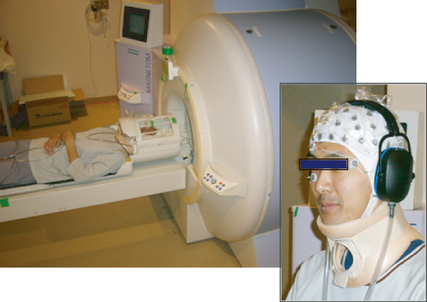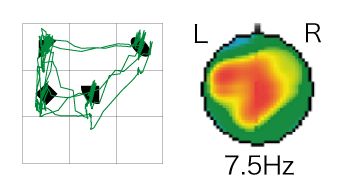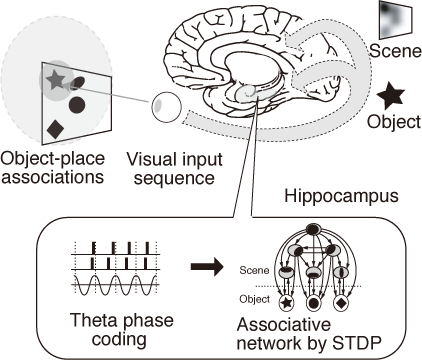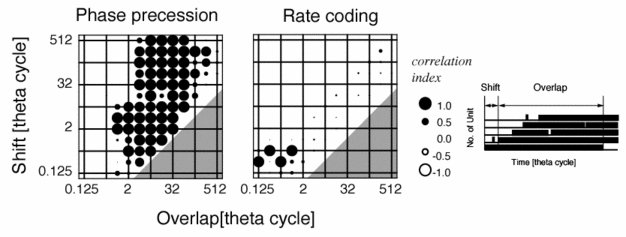|
Our human scalp EEG study demonstrated that EEG theta power and coherence during encoding increase in relation to the subsequently successful recall, while it remains unclear whether the hippocampus is associated with such a scalp EEG theta or not. To solve the questioin, we directory evaluated relation between the scalp EEG theta and the hippocampal activity by using a simultaneous EEG-fMRI recording. Eight participants completed an object-place memory task. BOLD signals were acquired with a 3-T Siemens Allegra MRI scanner during performing the task and 64-ch scalp EEG were simultaneously recorded. In the result, by removing large artifacts, we successfully detected the EEG theta power increase in relation to the subsequently successful recall. Moreover a cross-correlation analysis demonstrates that the EEG theta power at the central region is significantly correlated to the hippocampal BOLD response. These results support the hypotheses that hippocampal theta dynamics, as observed in the rat hippocampus, facilitates the memory encoding of what and where in human episodic memory.
|

|
We combine the computational model and human object-place association memory experiments to elucidate the computational theory of memory formation and recall. 350 trials of human eye movement data during 8s encoding of four object-place associations (from eleven subjects) were used in computer simulation of the model and the resultant network structure of the model and recall performance of human experiments were statistically analyzed. Our computational model study demonstrated that hierarchical network of asymmetric connections among CA3 units are robustly generated under experimentally obtained human saccadic sequences and that the correct recall in the model significantly correlated to a measure of a hierarchy structure. Importantly, the hierarchy measures obtained in the model were also significantly correlated with a human correct rate in the experiment. These results indicate the contribution of theta phase coding in a formation of object-place association memory and the functional significance of resultant hierarchical network in memory recall in human.
|

|
The computational theory of theta phase coding predicts that activation of theta rhythm in the brain during object-place memory encoding is followed by correct memory recall. In this study, we experimentally investigated the relationship between scalp EEG during performing the object-place association memory task with voluntary saccadic movements.
58-ch scalp EEG, 6-ch EOG and binocular eye movements were recorded from 12 subjects. Analyses of scalp EEGs indicated that the oscillation episodes in theta range are significantly correlated with correct memory recall. The correlation is high in the widely distributed central region, while correlation of EOGs is not significant in the theta range. Thus, we successfully caught brain activities in theta range distributed over multiple areas. Our finding supports the computational theory of theta phase coding on the memory encoding of object-place associations in humans. The theta phase coding can be a common neural dynamics among rodents and humans for the memory formation of the complex environment.
|

|
Object-place associative memory is hippocampal- dependent, where the conjunction of objects and places are stored in a one-time experience. The neural mechanism of information storage in this compound process is unclear. In this study, we hypothesize that neural dynamics, known as theta phase precession in the rat hippocampus, contributes to compound information processing because of its advantages in selective synaptic plasticity in an on-line process. To examine this hypothesis, we propose a neural network model of the cortico-hippocampal system, including central-peripheral visual pathways and theta phase coding in the hippocampus. Memory storage computer experiments demonstrate that the hippocampal network successfully stores object-place associations in a one-time experience. Interestingly, it is found that asymmetric connections encode the hierarchal structure between scenes and objects. We conclude that a complex environment with various spatial scales can be instantaneously stored as a hierarchal network because of the transformation of spatial scales in theta phase coding.
|

|
Recent experimental evidence on spike-timing-dependent plasticity and on phase precession (i.e., the theta rhythm dependent firing of rat hippocampal cells) associates the contribution of phase precession to episodic memory. This article aims at clarifying the role of phase precession in memory storage. Computer simulations show that the memory storage in the behavioral timescale varies in timescale of the temporal sequence from half a second to several seconds. In contrast, the memory storage caused by traditional rate coding is restricted to the temporal sequence within 40 ms. During phase precession, memory storage of a single trial experience is possible, even in the presence of noise. It is therefore concluded that encoding by phase precession is appropriate for memory storage of the temporal sequence in the behavioral timescale.
|

|
|